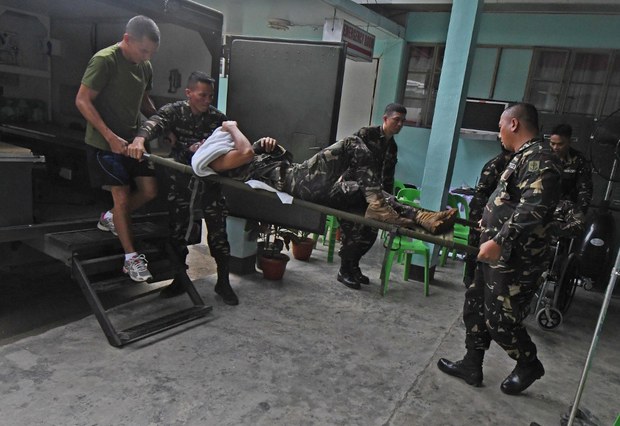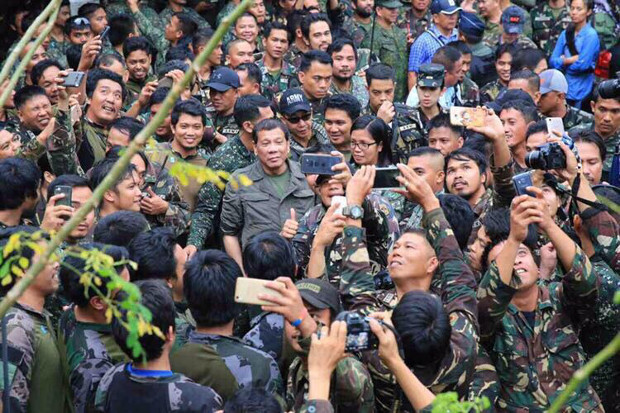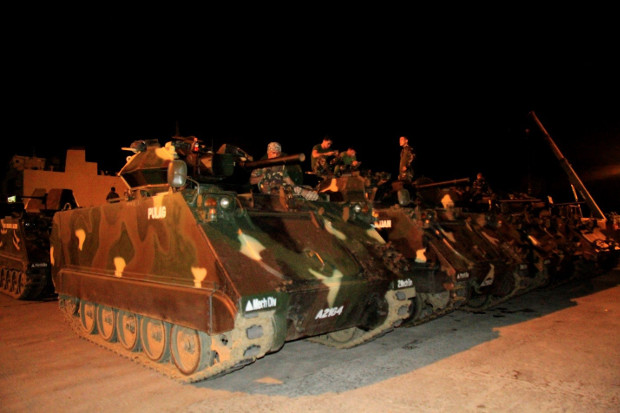Philippine President Pays Surprise Visit to Troops in Marawi
2017.08.04
Marawi and Iligan, Philippines
 Soldiers carry a wounded comrade on a stretcher at Camp Evangelista Emergency Station Hospital, in Cagayan de Oro city, Aug. 2, 2017.
Soldiers carry a wounded comrade on a stretcher at Camp Evangelista Emergency Station Hospital, in Cagayan de Oro city, Aug. 2, 2017.
Philippine President Rodrigo Duterte paid another surprise visit to Marawi on Friday to rally government troops battling fighters linked to the Islamic State (IS) who have stubbornly held onto pockets of the southern city for more than 10 weeks.
The visit, the president’s second to Marawi since July 20, came on the eve of regional meetings being hosted by Manila during which the situation in the besieged city figures to be on the agenda of discussions about security in Southeast Asia.
“I have to be here because I want all of you to know that … Mahal ko kayo [I love you all]. I hope you will be able to clean up Marawi City and get rid of the terrorists,” Duterte told troops belonging to the Joint Special Operation Task Force Trident during his visit to Camp Kilala, according to a transcript released by the presidential office in Manila.
Duterte said he was hopeful that the government would not lose more troops to the ongoing battle.
Like his first trip, the commander-in-chief’s second visit to Marawi was unannounced and confirmed by officials only after he had left the area, the presidential office said.

President Rodrigo Duterte visits troops in Marawi, Aug. 4, 2017. [Courtesy Presidential Communications Operations Office]
‘We don’t know how many are still alive’
Also on Friday, the Philippine military said it did not know how many of the estimated 300 people taken hostage by IS-linked militants in Marawi – as Duterte had claimed earlier – were alive after more than two months of fighting.
It has been tricky to get clear picture on the number of hostages who are alive because improvised bombs planted by the enemy have slowed down efforts by the military to advance deeper into the city, officials said.
The gunmen are believed to be controlling two villages that are “problematic areas” and less than about one-square kilometer in size, armed forces spokesman Brig. Gen. Restituto Padilla said.
“So in the local government’s tally, we continue to get about (an) approximate number of 300 individuals comprising all those who are still unaccounted for,” Padilla said.
“We don’t know how many are still alive and we don’t know how many are in the hands of the enemy exactly,” he said.
Based on estimates, about 80 to 100 people may be held hostage by the gunmen “inside the areas that are still contested,” Padilla said without explaining how officials arrived at the figures.
Since the fighting erupted on May 23, the number of gunmen slain has reached 522, with nine more enemy casualties reported Thursday. One hundred fourteen troops and 45 civilians have been killed as well, the military said.
Despite the casualties, he said the troops’ morale was high, with many rearing to “complete the liberation of Marawi,” Padilla said, but he begged off giving a more definite timeline.
“One is to always put our primary consideration, the safety of the remaining hostages and the possible rescue of all these individuals from the hands of terrorists,” he said.
Fighting began when troops moved to arrest the elusive leader of the Abu Sayyaf group, Isnilon Hapilon, who had been seen in Marawi.
But a huge rebel contingent, backed by followers of the Maute group and several militants from several Southeast Asian and Middle Eastern countries repulsed the initial government attack.
At the height of the fighting, the gunmen took control of the city center, forcing its 200,000 or so residents to vacate.
The fighting caught Duterte by surprise, forcing him to place the entire south under military rule for two months.
He later won an extension from Congress, arguing that despite the massive military presence, the gunmen’s fire power had repelled the offensive.
Long-time military allies the United States and Australia have been helping their Filipino counterparts in gathering intelligence, while neighbors Singapore, Malaysia and Indonesia have agreed to boost anti-terrorism cooperation, fearing IS fighters from Marawi could cross over to their borders.
Lt. Gen. Carlito Galvez, the regional army commander, on Thursday said surveillance revealed that Hapilon was inside Marawi – a huge morale boost for the militants.
And in a sign that the fighting would stretch longer, the military sent 18 tanks and delivered about 2000 new M4 rifles to troops on the frontline earlier this week.

Tanks arrive in the port of Iligan city to reinforce troops fighting Islamic State-linked militants in Marawi, Aug. 2, 2017. [Richel V. Umel/BenarNews]







